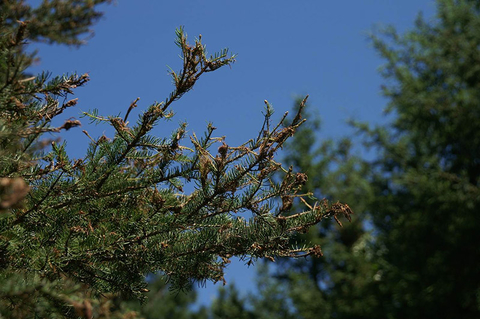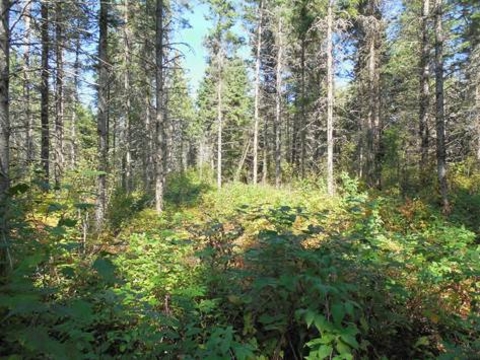Quick facts
-
Spruce budworm activity has been observed in Minnesota every year since at least 1954.
-
Management strategies include commercially thinning healthy stands to retain trees with greater than 40% live crown ratio.
-
Using pesticides to control spruce budworm is expensive and not very successful at treating forests, but is an option for saving yard trees.
-
If dead and dying trees are not removed, they become a fire hazard around homes and buildings and contribute to increased fire risk.
Managing spruce budworm in Minnesota forests
The eastern spruce budworm (Choristoneura fumiferana) is a native forest insect of concern across Minnesota’s coniferous forests. Spruce budworm is responsible for defoliating or killing vast acreages of balsam fir and spruce annually in Minnesota.
Despite its name, balsam fir trees are most susceptible to budworm while spruces are moderately susceptible. Fortunately, these important conifer species can be protected through effective forest management.
The impact of spruce budworm
Large-scale spruce budworm outbreaks in eastern Canadian provinces and northern New England typically occur every 30 to 40 years.
In Minnesota, budworm activity has been observed every year since at least 1954, representing an endemic budworm population for over 60 years. Budworm outbreaks in Minnesota typically occur in the same area every 25 to 40 years.
Estimates from the Department of Natural Resources suggest that annual budworm defoliation averaged 94,500 acres of Minnesota’s forests from 2010 through 2014.
The eastern spruce budworm is a native insect that has evolved with forests across the U.S. Great Lakes region.
Life cycle
Moths lay up to 10 egg masses on spruce and balsam fir needles in July. Larvae soon hatch from the eggs and spin down on a silk tread which can blow a considerable distance by wind. After overwintering, young larvae emerge just before balsam fir budbreak in the spring.
- Budworm larvae feed on new foliage growth through May and June then pupate and emerge as moths by mid-July.
- Adult moths will mate, lay eggs, and eventually die in the summer.
- Moths are effective fliers and use wind currents to disperse over long distances.
- Populations remain in the outbreak stage in a forest stand until much of its food source, such as mature and overmature balsam fir and spruce, is killed.
- When an outbreak of budworm occurs, it typically will remain in that area defoliating trees for the next 8 to 10 years.
Tree symptoms and vulnerability
- Budworm feeding damage is first noticed on outer branch shoots in the upper crowns of spruce and fir trees.
- Partially eaten needles are webbed onto branch tips and turn a reddish-brown color.
- Long-term damage of budworm defoliation can result in top kill in 2 to 3 years for balsam fir or 3 to 5 years in white spruce.
- Additional years of feeding cause tree mortality.
Species susceptibility
Repeated defoliation of Balsam fir gives the tree a low chance of survival and it will usually die after 3 to 4 years of defoliation.
White spruce has a better survival rate than balsam fir. Repeated defoliation gives the tree a moderate chance of survival, but it will usually die after 5 to 7 years of defoliation.
- An entire stand will rarely die following a budworm outbreak, but patches of trees within stands may die.
- Although trees can tolerate repeated defoliations (white spruce more so than balsam fir), tree growth is reduced.
- Smaller-diameter trees in an intermediate or suppressed crown position within the stand are more likely to die first.
- Many years of repeated defoliation can result in death of the majority of overstory and understory fir trees.
- Dense stands made up mostly of balsam fir and that have fewer non-host species are most vulnerable to budworm damage. Less susceptible stands have more non-host species and are comprised of healthy and vigorous trees (indicated by large live crown ratios—over 40% in white spruce).
Management strategies
Forest management actions can reduce losses from budworm damage.
If you start to notice budworm populations in stands of balsam fir, make plans to have them harvested as soon as possible to maintain their value. Don't wait to harvest trees.
In white spruce stands, both pre-commercial and commercial thinning strategies can be used to promote healthy and vigorous trees that can be less susceptible to spruce budworm damage. In white spruce plantations, pre-commercial thinning should be considered in stands with greater than 800 trees per acre.
- Plantations between 35 and 45 years old are most likely to respond well to commercial thinnings.
- Avoid thinning from above—removing trees from dominant and codominant trees to favor the best trees in those crown classes.
- Keep trees with greater than 40% live crown ratio (the ratio of the size of a tree's live crown to its total height).
- Plantations greater than 55 years old that have never been thinned are not likely to respond to thinning.
- Any stand and especially older stands thinned during a budworm outbreak will not respond favorably to thinning.
- Thinning adds additional stress to trees already stressed by budworm defoliation.
It is common for some trees to die following thinning. In particular, as white spruce is a shallow-rooted tree, injuries to roots, debarking and breakage may happen. Thinning can also lead to windthrow if too much basal area is removed.
If a stand is in a marketable condition and experiencing the beginning of a budworm outbreak, consider a pre-salvage harvest.
Thinning white spruce plantations to offset spruce budworm damage
| Scenario | Should you thin? | Considerations |
|---|---|---|
| Pre-commercial thinning: Young stands with greater than 800 trees per acre | YES | Remove 50% of trees. Retain trees with greater than 40% live crown ratios to promote a vigorous and healthy stand. |
| Commercial thinning: 35 to 45-year old stands in a healthy condition | YES | Commercially thin to basal area of 90 to 110 ft2/ac, or 50% of basal area. Retain trees with greater than 40% live crown ratios. |
| Older stands currently experiencing a spruce budworm outbreak | NO | Trees are unlikely to respond to thinning. Consider clearcutting. |
| Stands greater than 55 years old that have never been thinned | NO | Trees are unlikely to respond to thinning. Consider clearcutting. |
Harvest operator considerations
- Commercial thinning operations should occur on frozen ground with snow cover to minimize damage to roots.
- Avoid thinning operations on wet soil.
- Orient skid trails perpendicular to planted trees to allow harvesting equipment to keep a distance from the base of the tree.
- Leave 3 feet or more between equipment and trees to help prevent root damage.
For forest stands:
- Insecticides such as the bacterial pathogen Bacillus thuringiensis (Bt) have been successful in maintaining productivity in stands experiencing moderate infestations of spruce budworm.
- Spraying forests can keep trees alive while waiting for a harvest that will soon occur.
- The cost of multiple sprayings and the minimal success of treatments have led managers to seek less costly management strategies such as thinning.
Yard trees can be sprayed to protect foliage and kill spruce budworm.
- Pesticides must be applied early in the year prior to budworm needle feeding that begins in June.
- Applications will need to occur in each year during the budworm outbreak.
- Because the spray has to reach to the tops of tall trees, it is usually difficult for homeowners to get adequate spray coverage.
The Minnesota Department of Agriculture has a list of licensed pesticide applicators if a homeowner is considering pesticide application.
Otherwise, keep yard trees healthy by protecting root systems from damage, water during dry periods, and mulch around trees to help retain soil moisture.
Dead and dying trees are a fire hazard and must be removed from around homes and buildings.
CAUTION: Mention of a pesticide or use of a pesticide label is for educational purposes only. Always follow the pesticide label directions attached to the pesticide container you are using. Be sure that the area you wish to treat is listed on the label of the pesticide you intend to use. Remember, the label is the law.
Albers, J. and M. Albers. Spruce problem diagnosis for yard trees. Minnesota Department of Natural Resources. (PDF 2.56MB)
Anderson, D.P., and B.R. Sturtevant. 2001. Pattern analysis of eastern spruce budworm Choristoneura fumiferana dispersal. Ecography 34:488-497.
Batzer, H.O., and A.R. Hastings. 1980. How to rate spruce-fir vulnerability to budworm in Minnesota. US Department of Agriculture Forest Service, North Central Forest Experiment Station, St. Paul, MN.
D'Amato, A.W., S.J. Troumbly, M.R. Saunders, K.J. Puettmann, and M.A. Albers. 2011. Growth and survival of Picea glauca following thinning of plantations affected by eastern spruce budworm. Northern Journal of Applied Forestry 28:72-78.
Firewise in Minnesota. MN Department of Natural Resources.
Photo credits: Header image by Joseph OBrien, USDA Forest Service, Bugwood.org. Body images by Max McCormack, Mike Albers, and Matt Russell.
Reviewed in 2024




